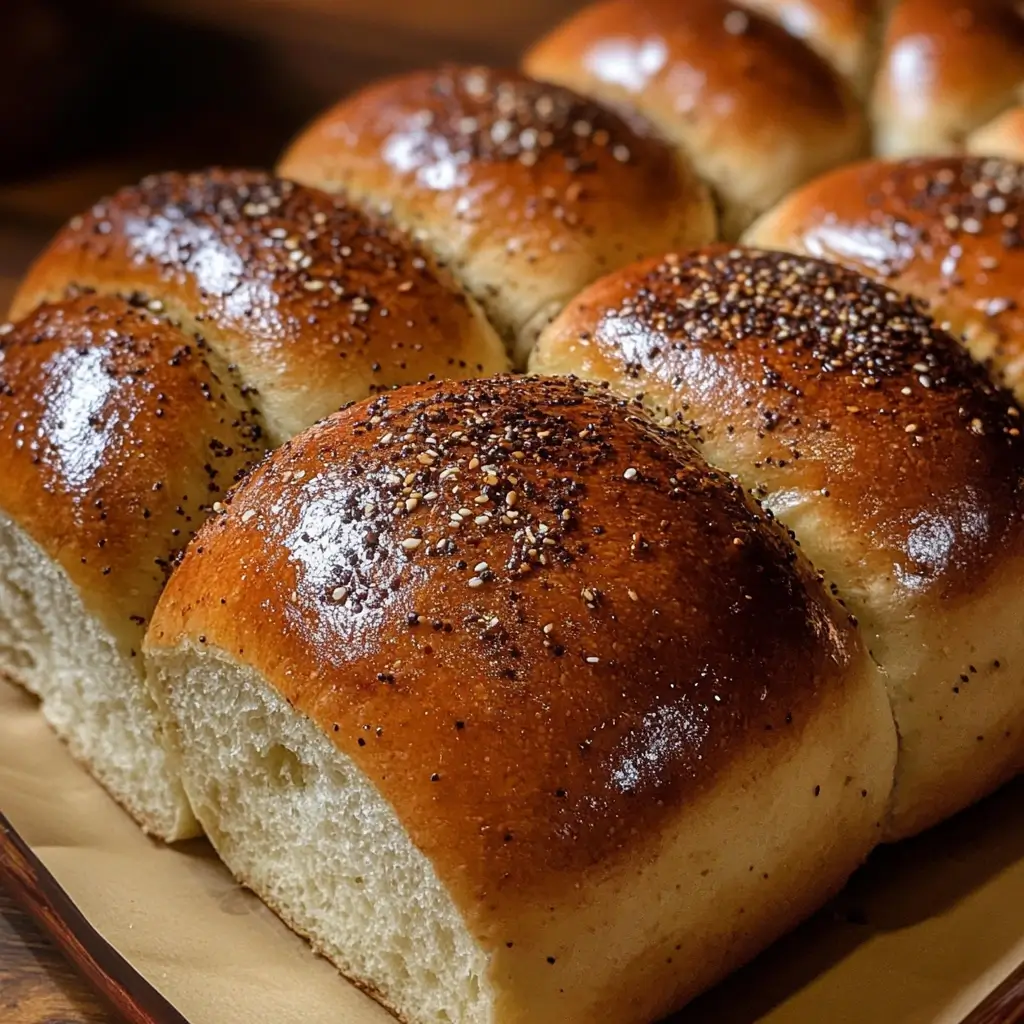The aroma of freshly baked rolls wafting through the house is truly one of life’s simple joys. For years, I’ve been on a quest for the perfect dinner roll – soft, fluffy, with a delicate crumb and just the right amount of richness. After countless attempts and tweaks, I finally landed on this recipe, and let me tell you, it’s a game-changer. My family devours these rolls practically before they even cool down enough to handle! Whether it’s Thanksgiving dinner, a casual weeknight meal, or just a craving for something comforting, these homemade rolls, slathered with creamy butter, are always a hit. The recipe is surprisingly straightforward, even for beginner bakers, and the reward is well worth the effort – warm, pillowy rolls that are simply irresistible. Get ready to impress your loved ones (and yourself!) with these truly delightful homemade rolls and butter.
Ingredients
For the Rolls:
- 3 ½ cups (420g) all-purpose flour, plus more for dusting
- 2 ¼ teaspoons (7g) active dry yeast
- 1 cup (240ml) warm milk (about 105-115°F or 40-46°C)
- ¼ cup (50g) granulated sugar
- 1 teaspoon salt
- 1 large egg, lightly beaten
- ¼ cup (57g) unsalted butter, melted and slightly cooled
For the Butter:
- 1 cup (240ml) heavy cream, cold
- ¼ teaspoon salt (or to taste)
Instructions
Making the Rolls:
- Activate the Yeast: In a large mixing bowl, combine the warm milk, sugar, and active dry yeast. It’s crucial that the milk is warm, not hot, to activate the yeast properly without killing it. The ideal temperature range is between 105-115°F (40-46°C). Let this mixture stand for 5-10 minutes, or until the yeast becomes foamy and bubbly. This indicates that the yeast is active and ready to leaven the dough. If the yeast doesn’t foam, it might be old or inactive, and you’ll need to start with fresh yeast.
- Combine Wet and Dry Ingredients: Once the yeast is activated, add the melted and slightly cooled butter, beaten egg, and salt to the yeast mixture. Stir gently to combine these wet ingredients. In a separate bowl, whisk together the all-purpose flour. Gradually add the dry ingredients to the wet ingredients, mixing with a wooden spoon or spatula until a shaggy dough forms.
- Knead the Dough: Turn the dough out onto a lightly floured surface. Knead the dough for 8-10 minutes, or until it becomes smooth, elastic, and slightly tacky but not sticky. Kneading is essential for developing the gluten in the flour, which gives the rolls their structure and chewy texture. If the dough is too sticky, add a tablespoon of flour at a time, but be careful not to add too much, as this can make the rolls tough. You can also use a stand mixer fitted with a dough hook to knead the dough for about 6-8 minutes on medium-low speed.
- First Rise (Bulk Fermentation): Place the kneaded dough in a lightly greased bowl, turning it to coat all sides. Cover the bowl with plastic wrap or a clean kitchen towel. Let the dough rise in a warm place for 1-1.5 hours, or until it has doubled in size. A warm place helps the yeast work efficiently. You can place the bowl in a slightly warmed oven (turned off), a sunny spot, or a warm corner of your kitchen. This first rise, also known as bulk fermentation, is crucial for developing flavor and texture in the rolls.
- Shape the Rolls: Once the dough has doubled, gently punch it down to release the air. Turn the dough out onto a lightly floured surface. Divide the dough into 12 equal portions. You can use a kitchen scale for accuracy if desired. Shape each portion into a smooth ball by gently stretching the top of the dough around to the bottom and pinching to seal. Place the shaped rolls in a greased 9×13 inch baking pan, spacing them evenly.
- Second Rise (Proofing): Cover the pan with plastic wrap or a clean kitchen towel. Let the rolls rise again in a warm place for 30-45 minutes, or until they have nearly doubled in size and are puffy. This second rise, called proofing, is the final rise before baking and ensures light and airy rolls.
- Bake the Rolls: Preheat your oven to 375°F (190°C). Once the rolls have proofed, bake them for 18-22 minutes, or until they are golden brown on top and sound hollow when tapped on the bottom. Keep an eye on them towards the end of baking to prevent over-browning. If they are browning too quickly, you can loosely tent the pan with foil.
- Cool and Serve: Remove the baked rolls from the oven and let them cool in the pan for a few minutes before transferring them to a wire rack to cool slightly. These rolls are best served warm, with homemade butter, of course!
Making the Butter:
- Chill Equipment: It’s essential to start with cold heavy cream and chilled equipment. Place your mixing bowl and whisk attachment (or beaters if using a hand mixer) in the freezer for about 15-20 minutes before you begin. This helps keep the cream cold and aids in the butter-making process.
- Whip the Cream: Pour the cold heavy cream into the chilled mixing bowl. Using a stand mixer or hand mixer, begin whipping the cream on medium speed. Initially, the cream will become frothy, then it will form soft peaks, and then stiff peaks, just like making whipped cream.
- Continue Whipping Beyond Stiff Peaks: Keep whipping the cream beyond the stiff peaks stage. At first, it might seem like you’ve gone too far and ruined it, but don’t worry! Continue whipping. The cream will start to look grainy and curdled. This is the butterfat separating from the buttermilk.
- Separate Butter and Buttermilk: Keep whipping until the butterfat clumps together and separates completely from the liquid buttermilk. This process can take anywhere from 5-15 minutes, depending on the speed of your mixer and the temperature of the cream. You’ll see a distinct separation – yellow butterfat clumps and a milky liquid (buttermilk).
- Drain the Buttermilk: Pour the mixture through a fine-mesh sieve or cheesecloth-lined colander set over a bowl. This will strain out the buttermilk, leaving the butterfat behind. Reserve the buttermilk for other uses like pancakes, waffles, or smoothies – it’s delicious and nutritious!
- Wash the Butter (Optional but Recommended): This step helps remove any remaining buttermilk from the butter, which will improve its flavor and shelf life. Place the butterfat back into the chilled mixing bowl. Add about ½ cup of ice-cold water. Mix on low speed for a few minutes, until the water becomes cloudy. Drain off the cloudy water. Repeat this washing process with fresh ice-cold water 2-3 more times, or until the water runs clear. This indicates that most of the buttermilk has been washed out.
- Salt and Shape the Butter: Add salt to the butter (¼ teaspoon or to taste). Mix to distribute the salt evenly. At this point, you can shape the butter as desired. You can press it into a butter dish, roll it into a log using parchment paper, or use butter molds. Store homemade butter in the refrigerator for up to 2 weeks.
Nutrition Facts
(Per serving – 1 roll and 1 tablespoon of butter, approximate values):
- Servings: 12 rolls (Butter yield varies, approximately 1 cup from 2 cups heavy cream, so about 16 tablespoons of butter)
- Calories per serving (Roll): Approximately 220-250 calories
- Calories per serving (Butter – 1 tbsp): Approximately 100 calories
- Total Calories per serving (Roll & Butter): Approximately 320-350 calories
- Fat: Approximately 15-20g (varies depending on butter portion and roll ingredients)
- Saturated Fat: Approximately 10-12g
- Cholesterol: Approximately 60-70mg
- Sodium: Approximately 150-200mg
- Carbohydrates: Approximately 30-35g
- Fiber: Approximately 1-2g
- Sugar: Approximately 5-7g
- Protein: Approximately 5-6g
Note: Nutritional information is an estimate and can vary based on specific ingredients and portion sizes. For precise nutritional information, use a nutritional calculator with the exact brands and quantities of ingredients used.
Preparation Time
- Prep Time: 45 minutes (including yeast activation, dough mixing, butter making)
- Rise Time (First Rise): 1 – 1.5 hours
- Rise Time (Second Rise): 30 – 45 minutes
- Bake Time: 18 – 22 minutes
- Total Time: Approximately 2 hours 30 minutes – 3 hours (including rise times)
How to Serve
These versatile rolls and homemade butter are perfect for a variety of occasions. Here are some serving suggestions:
- With Dinner:
- Serve alongside hearty soups and stews for dipping and soaking up delicious broth.
- Pair them with roasted chicken, turkey, or beef for a classic and comforting meal.
- Complement pasta dishes, lasagna, or spaghetti with garlic butter brushed rolls.
- Make them a side for grilled meats and vegetables during barbecues and cookouts.
- Accompany holiday meals like Thanksgiving, Christmas, and Easter dinners as a staple bread item.
- Breakfast & Brunch:
- Enjoy warm rolls with a smear of homemade butter and your favorite jam or jelly.
- Serve them with scrambled eggs, bacon, sausage, or omelets for a satisfying breakfast.
- Make mini breakfast sandwiches by slicing the rolls and filling them with eggs, cheese, and breakfast meats.
- Offer them alongside fruit salads, yogurt parfaits, or pancakes for a brunch spread.
- Appetizers & Snacks:
- Serve warm rolls with flavored butters like garlic herb butter, honey butter, or cinnamon butter as an appetizer.
- Offer them with savory dips like spinach artichoke dip, French onion dip, or hummus.
- Use them as a base for mini pizzas or bruschetta by topping them with savory ingredients and baking briefly.
- Sweet Treats (with a twist):
- Make cinnamon rolls by rolling the dough with cinnamon sugar before the second rise and baking.
- Create pull-apart monkey bread by coating dough balls in butter and cinnamon sugar and baking them together.
- Serve slightly sweet rolls with fruit compotes or whipped cream for a light dessert.
Additional Tips for Perfect Rolls & Butter
- Yeast Freshness is Key: Always ensure your yeast is fresh and active. If you’re unsure, proof it by mixing a teaspoon of yeast with warm water and a pinch of sugar. If it doesn’t bubble within 5-10 minutes, it’s likely inactive and should be replaced. Using fresh yeast guarantees proper leavening and fluffy rolls.
- Dough Temperature Matters for Rising: The ideal temperature for dough to rise is between 75-80°F (24-27°C). If your kitchen is too cold, the dough will rise slowly. You can create a warmer environment by placing the bowl in a slightly warmed oven (turned off) with the oven light on, or by placing it on top of the refrigerator (which is often slightly warmer). Conversely, if it’s too hot, the yeast can rise too quickly and exhaust itself, resulting in less flavorful rolls.
- Don’t Over-Knead or Under-Knead: Kneading is crucial, but both over-kneading and under-kneading can affect the texture of your rolls. Knead for the recommended time (8-10 minutes by hand, 6-8 minutes with a mixer) until the dough is smooth and elastic. Over-kneading can make the rolls tough, while under-kneading can result in dense and less airy rolls.
- Shape Rolls Uniformly for Even Baking: When shaping the rolls, aim for uniform size and shape. This ensures that they bake evenly. Using a kitchen scale to weigh the dough portions can help achieve consistency. Evenly shaped rolls will also look more appealing and professional.
- Proper Butter Washing Enhances Flavor and Storage: Washing homemade butter thoroughly is an important step often overlooked. Rinsing away the buttermilk removes milk solids that can spoil quickly and contribute to a tangy flavor that might not be desired in all butter applications. Washing the butter with ice-cold water several times ensures a cleaner, fresher flavor and extends its shelf life in the refrigerator.
FAQ Section
Q1: Can I use bread flour instead of all-purpose flour for the rolls?
A: Yes, you can substitute bread flour for all-purpose flour. Bread flour has a higher protein content, which will result in slightly chewier and more structured rolls. If using bread flour, your rolls might be a bit less tender but will still be delicious and have a good rise. For the softest rolls, all-purpose flour is generally preferred, but bread flour is a good alternative if you like a bit more chew.
Q2: Can I make the dough ahead of time and bake the rolls later?
A: Absolutely! You can make the dough ahead of time and let it have its first rise in the refrigerator overnight. This slow, cold rise actually enhances the flavor of the rolls. After the first rise in the refrigerator, punch down the dough, shape the rolls, and let them proof at room temperature for the second rise before baking as directed. You can also freeze the shaped rolls after the second rise. To bake from frozen, let them thaw and rise slightly at room temperature before baking, or bake directly from frozen, adding a few extra minutes to the baking time.
Q3: How do I know when the rolls are perfectly baked?
A: The rolls are perfectly baked when they are golden brown on top and sound hollow when you gently tap on the bottom of one roll. An internal temperature of around 200-210°F (93-99°C) is also a good indicator of doneness if you have a food thermometer. Avoid over-baking, as this can make the rolls dry.
Q4: How should I store leftover rolls to keep them fresh?
A: To keep leftover rolls fresh, store them in an airtight container at room temperature for up to 2-3 days. For longer storage, you can freeze them. Wrap the cooled rolls individually in plastic wrap and then place them in a freezer-safe bag or container. Frozen rolls can be stored for up to 2-3 months. To reheat frozen rolls, thaw them at room temperature or in the refrigerator, then warm them in a low oven (around 300°F or 150°C) for a few minutes until heated through and softened.
Q5: Can I add flavorings to the butter?
A: Yes, absolutely! Homemade butter is a fantastic base for flavored or compound butters. You can easily customize it by adding various ingredients. Some popular flavor additions include:
- Garlic Herb Butter: Mix in minced garlic, chopped fresh herbs like parsley, chives, thyme, or rosemary, and a pinch of salt and pepper.
- Honey Butter: Blend in honey and a touch of cinnamon or vanilla extract for a sweet and delicious butter.
- Maple Butter: Incorporate maple syrup and a dash of maple extract for a rich, autumnal flavor.
- Lemon Herb Butter: Add lemon zest, lemon juice, and chopped fresh herbs like dill or basil for a bright and zesty butter.
- Spicy Butter: Mix in chili flakes, cayenne pepper, or sriracha for a butter with a kick.
Simply soften the homemade butter slightly and mix in your desired flavorings until well combined. Compound butters add an extra layer of flavor and elevate your rolls to the next level!
Print
Rolls & Butter Recipe
Ingredients
For the Rolls:
- 3 ½ cups (420g) all-purpose flour, plus more for dusting
- 2 ¼ teaspoons (7g) active dry yeast
- 1 cup (240ml) warm milk (about 105-115°F or 40-46°C)
- ¼ cup (50g) granulated sugar
- 1 teaspoon salt
- 1 large egg, lightly beaten
- ¼ cup (57g) unsalted butter, melted and slightly cooled
For the Butter:
- 1 cup (240ml) heavy cream, cold
- ¼ teaspoon salt (or to taste)
Instructions
Making the Rolls:
- Activate the Yeast: In a large mixing bowl, combine the warm milk, sugar, and active dry yeast. It’s crucial that the milk is warm, not hot, to activate the yeast properly without killing it. The ideal temperature range is between 105-115°F (40-46°C). Let this mixture stand for 5-10 minutes, or until the yeast becomes foamy and bubbly. This indicates that the yeast is active and ready to leaven the dough. If the yeast doesn’t foam, it might be old or inactive, and you’ll need to start with fresh yeast.
- Combine Wet and Dry Ingredients: Once the yeast is activated, add the melted and slightly cooled butter, beaten egg, and salt to the yeast mixture. Stir gently to combine these wet ingredients. In a separate bowl, whisk together the all-purpose flour. Gradually add the dry ingredients to the wet ingredients, mixing with a wooden spoon or spatula until a shaggy dough forms.
- Knead the Dough: Turn the dough out onto a lightly floured surface. Knead the dough for 8-10 minutes, or until it becomes smooth, elastic, and slightly tacky but not sticky. Kneading is essential for developing the gluten in the flour, which gives the rolls their structure and chewy texture. If the dough is too sticky, add a tablespoon of flour at a time, but be careful not to add too much, as this can make the rolls tough. You can also use a stand mixer fitted with a dough hook to knead the dough for about 6-8 minutes on medium-low speed.
- First Rise (Bulk Fermentation): Place the kneaded dough in a lightly greased bowl, turning it to coat all sides. Cover the bowl with plastic wrap or a clean kitchen towel. Let the dough rise in a warm place for 1-1.5 hours, or until it has doubled in size. A warm place helps the yeast work efficiently. You can place the bowl in a slightly warmed oven (turned off), a sunny spot, or a warm corner of your kitchen. This first rise, also known as bulk fermentation, is crucial for developing flavor and texture in the rolls.
- Shape the Rolls: Once the dough has doubled, gently punch it down to release the air. Turn the dough out onto a lightly floured surface. Divide the dough into 12 equal portions. You can use a kitchen scale for accuracy if desired. Shape each portion into a smooth ball by gently stretching the top of the dough around to the bottom and pinching to seal. Place the shaped rolls in a greased 9×13 inch baking pan, spacing them evenly.
- Second Rise (Proofing): Cover the pan with plastic wrap or a clean kitchen towel. Let the rolls rise again in a warm place for 30-45 minutes, or until they have nearly doubled in size and are puffy. This second rise, called proofing, is the final rise before baking and ensures light and airy rolls.
- Bake the Rolls: Preheat your oven to 375°F (190°C). Once the rolls have proofed, bake them for 18-22 minutes, or until they are golden brown on top and sound hollow when tapped on the bottom. Keep an eye on them towards the end of baking to prevent over-browning. If they are browning too quickly, you can loosely tent the pan with foil.
- Cool and Serve: Remove the baked rolls from the oven and let them cool in the pan for a few minutes before transferring them to a wire rack to cool slightly. These rolls are best served warm, with homemade butter, of course!
Making the Butter:
- Chill Equipment: It’s essential to start with cold heavy cream and chilled equipment. Place your mixing bowl and whisk attachment (or beaters if using a hand mixer) in the freezer for about 15-20 minutes before you begin. This helps keep the cream cold and aids in the butter-making process.
- Whip the Cream: Pour the cold heavy cream into the chilled mixing bowl. Using a stand mixer or hand mixer, begin whipping the cream on medium speed. Initially, the cream will become frothy, then it will form soft peaks, and then stiff peaks, just like making whipped cream.
- Continue Whipping Beyond Stiff Peaks: Keep whipping the cream beyond the stiff peaks stage. At first, it might seem like you’ve gone too far and ruined it, but don’t worry! Continue whipping. The cream will start to look grainy and curdled. This is the butterfat separating from the buttermilk.
- Separate Butter and Buttermilk: Keep whipping until the butterfat clumps together and separates completely from the liquid buttermilk. This process can take anywhere from 5-15 minutes, depending on the speed of your mixer and the temperature of the cream. You’ll see a distinct separation – yellow butterfat clumps and a milky liquid (buttermilk).
- Drain the Buttermilk: Pour the mixture through a fine-mesh sieve or cheesecloth-lined colander set over a bowl. This will strain out the buttermilk, leaving the butterfat behind. Reserve the buttermilk for other uses like pancakes, waffles, or smoothies – it’s delicious and nutritious!
- Wash the Butter (Optional but Recommended): This step helps remove any remaining buttermilk from the butter, which will improve its flavor and shelf life. Place the butterfat back into the chilled mixing bowl. Add about ½ cup of ice-cold water. Mix on low speed for a few minutes, until the water becomes cloudy. Drain off the cloudy water. Repeat this washing process with fresh ice-cold water 2-3 more times, or until the water runs clear. This indicates that most of the buttermilk has been washed out.
- Salt and Shape the Butter: Add salt to the butter (¼ teaspoon or to taste). Mix to distribute the salt evenly. At this point, you can shape the butter as desired. You can press it into a butter dish, roll it into a log using parchment paper, or use butter molds. Store homemade butter in the refrigerator for up to 2 weeks.
Nutrition
- Serving Size: one normal portion
- Calories: 320-350
- Sugar: 5-7g
- Sodium: 150-200mg
- Fat: 15-20g
- Saturated Fat: 10-12g
- Carbohydrates: 30-35g
- Fiber: 1-2g
- Protein: 5-6g
- Cholesterol: 60-70mg





